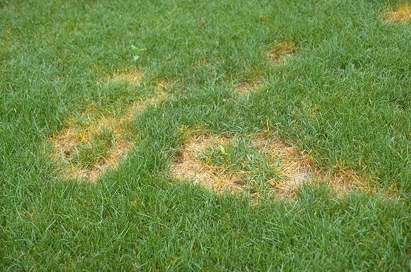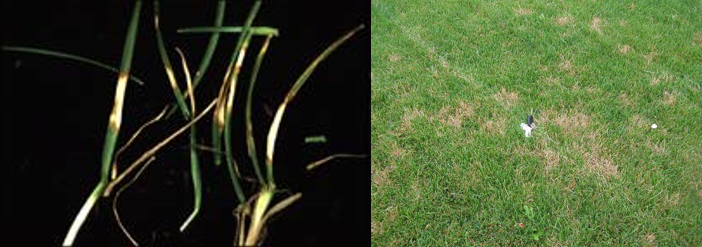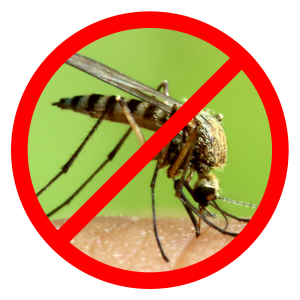Treating Summer Patch and Dollar Spot in the Summer Months

There are many diseases during the summer that can cause significant damage to lawns in New Jersey. The impact of these diseases can produce devastating effects and costly repairs to your lawn.
Summer Patch

One of the worst diseases is summer patch disease. Summer patch is a root disease that primarily affects Kentucky bluegrass; it can also cause damage to creeping red fescues and hard fescues, while tall fescues, creeping bentgrasses and perennial rye grasses are not impacted by this disease. Because this is a root disease, it is very hard to diagnose summer patch early.
Summer patch is a disease of hot weather conditions and usually the signs and symptoms present themselves between July and September. That being said, infection happens early in the spring when soil temperatures get above 65 degrees. After infection, small patches of turf form and turn a brown/orange color with green colored turf in the center. These small patches can expand to 1 – 3 feet in diameter and resembles a “frog eye” pattern. Multiple rings coalesce to form a larger blighted area.
The best way to avoid or reduce summer patch is to improve cultural practices, and/or apply fungicide applications. Most fungicide applications are for foliar diseases and require no watering. Since summer patch is a root disease, any fungicide applied needs to be watered into the root zone to be effective. Fungicides for summer patch are applied prior to seeing the effects of the disease. We at Fairway Green Inc. recommend three fungicide applications annually, once per month starting in May and ending in July as a preventative. After the disease symptoms are present, the damage has been done to the lawn and fungicides are less beneficial.
Summer patch is most severe in lawns that have poor drainage and are under drought stress. Other factors include thick thatch, soil compaction, improper mowing and improper watering. First, we recommend managing thatch and soil compaction in the lawn. Thatch is the loose organic layer of dead and living shoots, stems and roots that develop between the root zone of the grass blades and the soil surface. Ideally, this layer should be no more than 1/2 inch in thickness. An excessive layer of thatch inhibits the growth of the roots deeper into the soil, which limits access to water as well as many other nutrients. The thatch layer is also the location for the fungi to live, overwinter, grow and infect the root system in the spring. Core aeration is the most common way to help reduce the thatch layer, because it works by mechanically removing plugs of soil from the lawn. This immediately improves water and nutrient flow deeper into the soil, as well as promotes root growth for a healthier, more stress tolerant plant. Other benefits include increased oxygen levels to the soil, improved soil pore space, reduction in thatch build up, and enhanced response to fertilizers. After a core aeration is done, it would also be a great time to overseed the lawn. Core aeration gives the new seed contact with the soil which produces better germination.
Damaged areas caused from summer patch need to be seeded to repair the lawn. We recommend overseeding the lawn with perennial ryegrass. Ryegrass is not affected by summer patch disease and looks similar to Kentucky bluegrass. Rye grass helps mask the symptoms of summer patch disease in the future. To have any success at incorporating enough ryegrass types into the existing turf stand, summer patch lawns need to be core aerated and overseeded annually.
Water properly. Avoid light, frequent irrigation in the early morning while surface moisture is present. Deep, infrequent watering that occurs between 12 am – 6 am is best way and time to water a lawn. Underground irrigation systems should be run 1 – 1 ½ hours per zone every third or fourth day, while hose-end sprinklers should be run 3 – 4 hours per zone once per week. The goal is to get 1 inch of water on the lawn per week. It is also beneficial to not let your lawn become drought stressed in the first place. Keeping to a regular watering schedule has more benefits for your lawn in the long run. If you would like a more in-depth description about watering properly, read our blog article on lawn watering techniques.
Another cultural practice that helps reduce and avoid summer patch is proper mowing. Because this disease is a root disease, it favors low cut turf. When the grass is cut short it promotes a weak, shallow root system. Keep the grass cut high 3 – 3 ½ inches and only take off the top 1/3 of the grass blade at a time while mowing. Leaving the grass clippings behind also adds beneficial nutrients into the soil and will not contribute to the development of excess thatch buildup.
Finally keep the pH of the soil in a summer patch lawn slightly acidic. We recommend for lawns that have a history of summer patch disease, to be in a pH range between 5.8 – 6.0 just under the optimum range (6.3 – 6.5). When the pH is in the optimum range or higher, the effects of summer patch disease tend to be worse for a lawn. Conversely it is not recommended to let the pH of the soil get too low either. If the pH falls too low, the grass plants do not fully utilize the nutrients from fertilizers and suffer from nutrient deficiencies. To know the pH level of a lawn’s soil, a soil test needs to be performed and lime should only be considered and applied based on the results of the soil test. Check out our blog article to learn more about the pH of your lawn.
Dollar Spot
The next summer lawn disease is Dollar spot. Dollar spot is a foliar disease which is characterized by small “silver dollar-sized” spots of bleached turf. This disease can occur on any type of grass variety throughout our area annually. The affected grasses show white to straw-colored lesions that progress from the leaf tip downward or straight across the leaf blades. A brown border surrounds each lesion and appear in an hourglass shape. The individual leaf blades may contain many small lesions or one large one. Infected leaves become blighted, turning white to straw-colored as lesions expand and coalesce.

Dollar spot is most active July through August each year. Temperatures between 60 and 85 degrees and long periods of leaf wetness from dew, rain, or sprinkler irrigation favor the growth of this disease. Prolonged wet foliage is a key factor to this disease. However if conditions are favorable, activity can start early in June and continue into September. Activity can become widespread very quickly within a few days, and spots sometimes coalesce forming larger areas of bleached turf several feet in diameter. However, injury to established turf is almost never permanent.
Grass plants grow off the affected portions of the leaves allowing the disease to be mowed away. However, because dollar spot occurs in the summer when turf growth is slow, this can take weeks. Deep, infrequent watering occurring between 12am and 6am every third or fourth day is the best course of action. Underground irrigation systems should be run 1 – 1 ½ hours per zone, while hose-end sprinklers should be run 3-4 hours per zone. It is important to avoid frequent, light irrigation as this only promotes further spreading of the disease.
Maintaining an adequate nitrogen fertility in the soil is also important when treating dollar spot. Dollar spot disease favors lawns with low nitrogen, so applying a regular fertilizer throughout the season helps increase the nitrogen in the soil and reduce dollar spot activity.
Keep the grass cut high 3 – 3 ½ inches and take off 1/3 of the grass blade at a time while mowing.
Core Aerate regularly to reduce the thatch layer and reduce soil compaction. Keep the thatch layer at 1/2 inch in thickness. Further, core aeration immediately improves water and nutrient flow deeper into the soil, as well as promotes root growth for a healthier, more stress tolerant plant.
Apply a fungicide. A fungicide is meant to stop the further spreading of the disease to uninfected areas of the lawn. A fungicide gives about 20-30 days of control depending on site conditions allowing the lawn some time to grow out the disease and recover without it spreading further. If the environmental conditions remain favorable after the 20-30 day period, another fungicide may need to be applied to continue control of the disease.
Conclusion
If you are in our service area, and your lawn is showing signs of summer patch or dollar spot disease, feel free to give our office a call at 908-281-7888. If you are in our service area or a current customer, Fairway Green Inc. is happy to come out and take a look.




